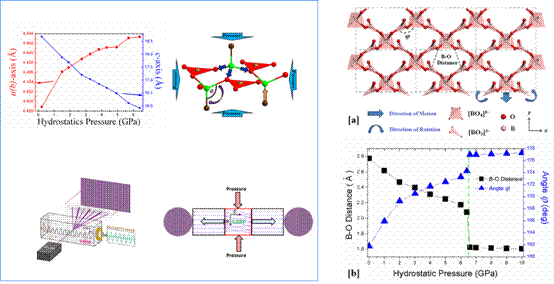Majority of materials would contract three-dimensionally, when subjected to hydrostatic pressure. However, very rare materials expand along some direction under hydrostatic pressure, called negative compressibility. Negative compressibility is a novel intrisic mechanical property of materials, which not only challenge the common sense about the physical property of materials, but also have great application potential in many scientific and technical fields, and hence is one of the most leading topics in materials science for decades. Collaborating with Prof. Wei Li in Huazhong University of Science and Technology, the group directed by Prof. Zheshuai Lin in Technical Institute of Physics and Chemistry CAS take the leading in the study of negative compressibility in borates. Taking advantage of the high pressure powder X-ray diffraction at 4W2 beamline of Beijing Synchrotron Radiation Facility, combined with first-principles calculation, they discovered the isotropic negative area compressibility (NAC) in KBBF(KBe2BO3F2) crystal, and confirm the giant negative linear compressibility (NLC) in BIBO(α-BiB3O6). Meanwhile, they also investigate the microscopic mechanism of the rare compressive behavior in the two materials. Their research have been published on July 17th, 2015 in《Advanced Materials》and August 25th, 2015 in《Scientific Reports》.
Their study about KBBF(left figure) revealed that it possessed the NAC behavior between 0.22 to 6.39GPa (with the compressibility -1.0(2)/TPa), which is the third inorganic material with this rare property. The microscopic structure of the anomalous mechanical property originate the concerted distortion in (BeO3F)5- tetrahedra, extruded by the rapid collapse between (Be2BO3F2)∞ layers. Meanwhile, based on the NAC behavior in KBBF, they further proposed its novel application in strain-converting and ultraviolet acoustic-optics device.
Their study about BIBO (right figure) revealed its giant NLC behavior between 0 to 6.5GPa (with the compressibility -11.7/TPa), which is the largest in inorganic materials. Its NLC behavior is determined by the peculiar “umbrella-like” topology in BIBO, in which BiO4 is the “umbrella stand” and BO3 triangle is the rotatable “umbrella surfaces”. More interesting, owing to the long pair electrons at Bi3+ ion, the space occupied by the “umbrella” unit is further enlarged, and the whole microstructure is easy to be distorted under pressure and hence lead to giant NLC behavior. The study verified for the first time that apart from the topological structure of atomic arrangement, electron distribution is also very critical for the negative compressibility.
The discovery of NAC in KBBF and mechanism of giant negative compressibility in BIBO have significant implication to the exploration of negative compressibility materials. Famous materials science media “Materials views” spoke highly of the study about the negative compressibility in borate: “The present study revives the studies on new functionalities in borates, which have been long overlooked, and may eventually lead to discoveries of more exciting and exotic emerging physical properties”. Exactly, in borates, boron and oxygen atoms can form [BO3] and [BO4] groups, and the further combination of the two groups can produce much more types of building blocks. This will bring rich structural diversity and novel physical property to borates.

Left figure: in KBBF, originated from the concerted distortion of (BeO3F)5- tetrahedra in (Be2BO3F2) ∞ layer, (a,b) plane expand with increasing pressure (NAC), and the NAC behavior in KBBF has potential application in strain-converting and acoustic-optics device. Right figure: the giant NLC behavior of BIBO stem from “umbrella-like” structure, in which the Bi3+ ions with long pair electron play the role of “umbrella stand” to enlarge the space required by the rotation between rigid [BO3] and [BO4] group.
Article:
Xingxing Jiang, Siyang Luo, Lei Kang, Pifu Gong, Wenjiao Yao, Hongwei Huang, Wei Li ,* Rongjin Huang, Wei Wang, Yanchun Li, Xiaodong Li, Xiang Wu, Peixiang Lu, * Laifeng Li, Chuangtian Chen, and Zheshuai Lin*, Isotropic Negative Area Compressibility over Large Pressure Range in Potassium Beryllium Fluoroborate and its Potential Applications in Deep Ultraviolet Region. Advanced Materials 2015, 27, 4851–4857.


